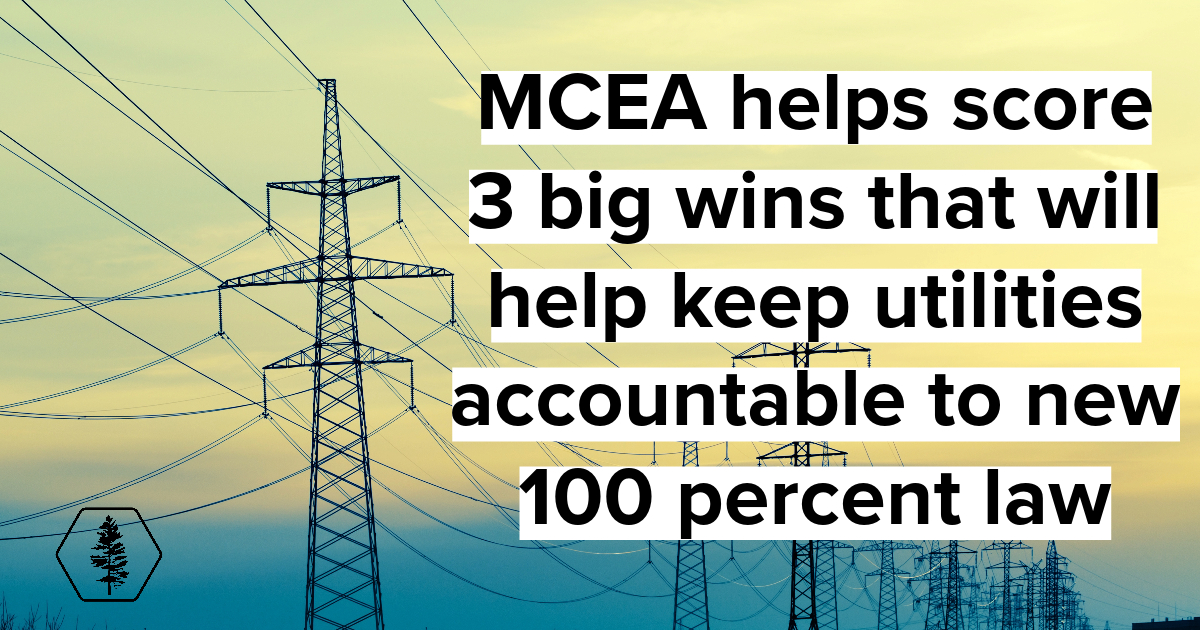MCEA scores important wins for more climate-conscious energy-planning

MCEA’s staff attorney and decades-long climate advocate, Barb Freese, remembers the first time the Minnesota Public Utilities Commission (PUC) confronted climate change questions back in the 1990s.
“It was a huge deal,” Freese recalls. “The climate deniers all came out. The coal industry freaked out and sent in all these people to testify about how climate change wasn’t real, or if it was real, how we were probably going to enjoy it.”
Before we get into it, you should know that the PUC is the state agency in charge of overseeing energy planning in Minnesota and ensuring utility companies put forward plans to meet energy demands that protect ratepayers, and to a broader extent, the general public.
Rewind back to the 90s, when the threat of climate change was just starting to surface publicly and the PUC was pushed to acknowledge it. The agency had a long proceeding to determine how utilities’ energy plans should account for the threat climate change posed to crop yields, human health, residential infrastructures, etc…. In other words, how the plans that continued to rely on energy sources that contributed to climate change would reflect the cost of the damage those sources would likely cause to society, now known as the social cost of carbon.
The PUC ended up placing a now laughably nominal price-range on the social cost of carbon emissions - called an externality cost - at the end of it: 30 cents to $3.10 a ton. The externality cost range matters because the lower it is, the less emphasis PUC and utility companies place on climate impacts when deciding whether to prioritize renewable or fossil-fuel sources to power our grid.
MCEA and our allies pushed the PUC to update its climate externality cost estimate years ago, but the PUC’s cost range still remained far too low. That changed dramatically this year, thanks to the passage of the 100 percent clean energy law MCEA worked hard to help pass last legislative session. The law - now referred to as the 100 percent carbon-free law – requires all utilities doing business in Minnesota to use carbon-free sources for electricity by 2040.
The law also mandated the PUC to use the Environmental Protection Agency’s dramatically higher externality costs in the utility energy planning process - placing the new range at $125 to $351 per ton of carbon emissions, and rising yearly.
While the inclusion of such a massive jump in externality costs in the bill alone was a huge success, not to mention the passage of the bill in its entirety, we all know good laws can be eroded without strong implementation and enforcement efforts. That’s why Freese showed up at the PUC’s Cost of Carbon hearing earlier this month ready to push for big changes in the utility planning process aimed at ensuring compliance with both the letter and the spirit of the 100 percent law.
She had three top requests, and the PUC voted unanimously to approve all of them. It was a full-circle moment in Freese’s decades-long climate career, and it shows how far Minnesota has come on this vital issue.
The wins are complicated, but in an oversimplified nutshell, here’s what MCEA achieved:
- The closure of a long problematic loophole that allowed utility companies to avoid recognizing the true climate damage caused by their power plants’ pollution by paying a modest regulatory fee. If this loophole had not been closed, the new climate cost estimates required by the 100 percent law would have been severely obscured in the energy planning process.
- The tripling of a portion of the other key climate cost - called the regulatory cost - considered in the energy planning process. The regulatory cost attempts to project how much future climate regulations will increase the costs of running fossil-fuel burning power plants, like through a carbon tax or a requirement to install pollution controls. This change recognizes that even the 100 percent law does not necessarily cut carbon emissions fast enough, and ongoing emissions will face additional regulatory pressure as the climate crisis accelerates.
- Mandated planning for compliance with the 100 percent law reflected in utilities’ energy plans. This is important because a utility company could make an argument in 2035 that it’s too expensive to comply with the 2040 deadline and potentially get a waiver of sorts from the law. By mandating individualized planning now, utility companies have to start anticipating these changes and budgeting for them immediately.
Here’s what Freese says about the outcome:
“We’ll have to wait and see what happens when the rubber meets the road but these changes should create a far more rational process in which both the PUC and the utilities will need to take the climate crisis much more seriously moving forward.”
As always, MCEA will be on hand to make sure that happens.